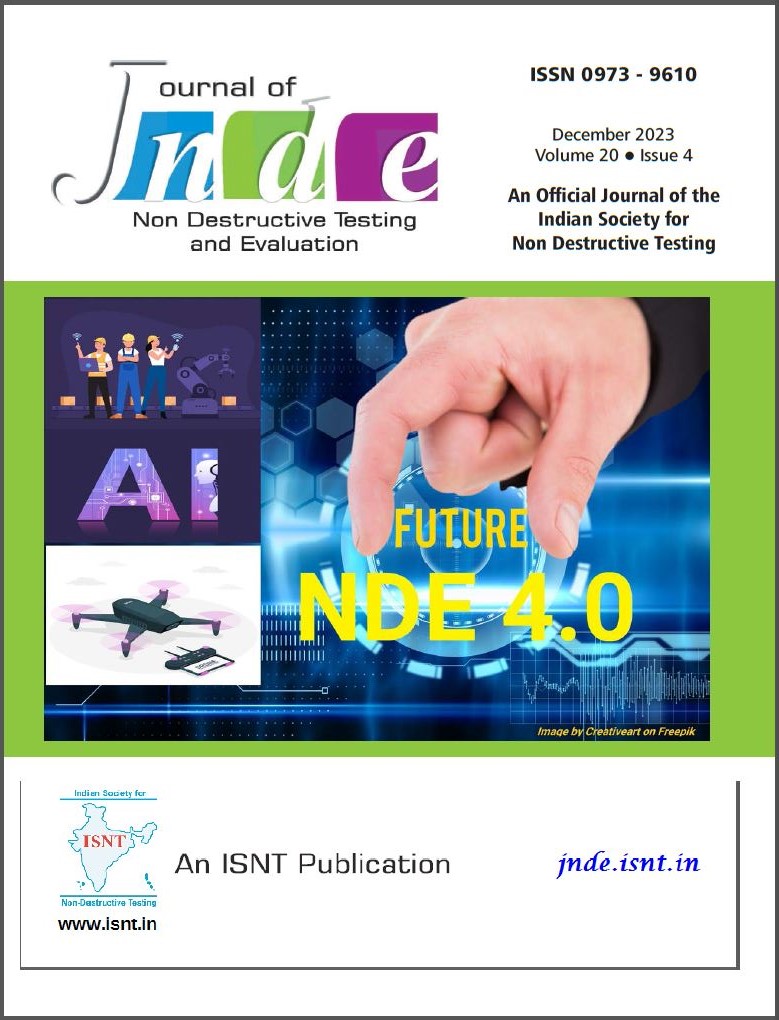AI-Driven CFRP Structure Evaluation: Deep Learning-Powered Automated Air-Coupled Ultrasonic Detection of Defect

Published 07-12-2023
Keywords
- Ultrasonic-Testing,
- Defect identification,
- Carbon Fiber Reinforced Polymers,
- Convolutional neural networks
How to Cite
Copyright (c) 2024 Journal of Non-Destructive Testing and Evaluation (JNDE)

This work is licensed under a Creative Commons Attribution-NonCommercial-NoDerivatives 4.0 International License.
Abstract
In this study, the successful experiments with air-coupled ultrasonic testing (ACUT) conducted on a 300 mm x 300 mm CFRP laminate, constructed from unidirectional Carbon Fibres, has been designed to simulate various types of damage during manufacturing, were presented as part of the experimental data. It was noted that the ACUT results exhibited strong correlations with the ground truth. To improve automated defect detection, a two-stage process was introduced. In the initial stage, C-Scan data acquired from the ACUT system was utilized. This data underwent meticulous analysis by a Convolutional Neural Network (CNN) image classifier, which categorized the images into two primary classes: defects and non-defects. Subsequently, defect instances underwent in-depth processing using Mask R-CNN, a technique that generated bounding boxes and segmentation masks for each defect zone within the images. The entire process was executed utilizing TensorFlow. The ultimate objective of this approach was to provide inspectors with the requisite tools to promptly and accurately discern and assess defects in composite materials, with the potential to substantially enhance the efficiency and precision of quality control processes in composite structures.
References
- Degenhardt, Richard et al. “Future structural stability design for composite space and airframe structures”, Thin-Walled Structures 81 (2014): 29-38.
- M.O.W. Richardson and M.J. Wisheart, “Review of low-velocity impact properties of composite materials”, Composites Part A: Applied Science and Manufacturing, Vol. 27, Issue 12 (1996).
- Cheng, Xiaoying, et al., “Automatic defect depth estimation for ultrasonic testing in carbon fiber reinforced composites using deep learning”, NDT & E International 135 (2023): 102804.
- Silva, Maria Inês et al., “Review of conventional and advanced non-destructive testing techniques for detection and characterization of small-scale defects”, Progress in Materials Science (2023): 101155.
- Pannier, Yannick et al., “Automatic segmentation and fibre orientation estimation from low resolution X-ray computed tomography images of 3D woven composites”, Composite Structures 318 (2023): 117087.
- Guo, Rui et al., “Deep-learning image enhancement and fibre segmentation from time-resolved computed tomography of fibre-reinforced composites”, Composites Science and Technology 244 (2023): 110278.
- Lecompagnon, Julien et al., “Non-destructive thermographic detection of internal defects using pixel-pattern based laser excitation and photothermal super resolution reconstruction”, Scientific Reports 13.1 (2023): 3416.
- Daghigh, Vahid, and Mohammad Naraghi, “Machine learning-based defect characterization in anisotropic materials with IR-thermography synthetic data”, Composites Science and Technology 233 (2023): 109882.
- Hung, Y. Y., and H. P. Ho, “Shearography: An optical measurement technique and applications”, Materials science and engineering: R: Reports 49.3 (2005): 61-87.
- Hung, Michael YY, HuaiMin Shang, and Lianxiang Yang, “Unified approach for holography and shearography in surface deformation measurement and non-destructive testing”, Optical engineering 42.5 (2003): 1197-1207.
- Yu, Yeun-Ho, et al., “A study on the failure detection of composite materials using an
- acoustic emission”, Composite structures 75.1-4 (2006): 163-169.
- Kordatos, E. Z., D. G. Aggelis, and T. E. Matikas, “Monitoring mechanical damage in structural materials using complimentary NDE techniques based on thermography and acoustic emission”, Composites Part B: Engineering 43.6 (2012): 2676-2686.
- Y. Guo, Z. Xiao, L. Geng, J. Wu, F. Zhang, Y. Liu, W. Wang, “Fully convolutional neural network with GRU for 3D braided composite material flaw detection”, IEEE Access 7 (2019) 151180–151188.
- Y. Yan, D. Liu, B. Gao, G. Tian, Z. Cai, “A deep learning-based ultrasonic pattern recognition method for inspecting girth weld cracking of gas pipeline”, IEEE Sensors Journal 20 (2020) 7997–8006.
- M. Yuan, J. Li, Y. Liu, X. Gao, “Automatic recognition and positioning of wheel defects in ultrasonic B-Scan image using artificial neural network and image processing”, Journal of Testing and Evaluation 48 (2019) 308–322.
- D. Medak, L. Posilović, M. Subašić, M. Budimir, S. Lončarić, “Automated defect detection from ultrasonic images using deep learning”, IEEE Transactions on Ultrasonics, Ferroelectrics, and Frequency Control (2021).
- I. Virkkunen, T. Koskinen, O. Jessen-Juhler, J. Rinta-Aho, “Augmented ultrasonic data for machine learning”, Journal of Non-destructive Evaluation 40 (2021) 1–11.
- M. Słoński, K. Schabowicz, E. Krawczyk, “Detection of flaws in concrete using ultrasonic tomography and convolutional neural networks”, Materials 13 (2020) 1557.
- J. Ye, N. Toyama, Benchmarking deep learning models for automatic ultrasonic imaging inspection, IEEE Access 9 (2021) 36986–36994.
- Cantero-Chinchilla, Sergio, Paul D. Wilcox, and Anthony J. Croxford, “Deep learning in automated ultrasonic NDE–developments, axioms and opportunities”, NDT & E International (2022): 102703.
- Tsung-Yi Lin, Maire, M., Belongie, S. J., Bourdev, L. D., Girshick, R. B., Hays, J., … Zitnick, C. L. (2014). Microsoft COCO: Common Objects in Context. CoRR, abs/1405.0312. Retrieved from http://arxiv.org/abs/1405.0312.
